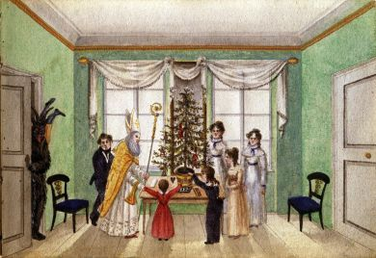
Under Joseph I. there were already written descriptions of a green tree with small burning candles. Long before that, on December 6th, Saint Nicholas often brought a small coniferous tree that was full of baked goods and fruits but still without candles.
In some countries children are told that St. Nicholas brings a Christmas tree and many presents to good children.
At that time the presents were more likely to be given on St.Nicholas‘s day.
Some curious children try to not fall asleep so that they can finally see St. Nicholas (maybe also known as Santa Claus) and thank him for everything but instead of him they just can watch their grandpa or dad by putting the tree in the living room.
This children will thank for that love all their lives long by always trying to do the right thing and also to help other people when they really need it, without asking them for gratitude or reward.
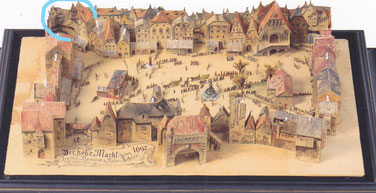
More than 200 years ago a banker's wife and daughter named Fanny von Arnstein ran a salon on the corner of Hoher Markt 1 and Landskrongasse 2, which became a center of social life, especially at the time of the Congress of Vienna.
Artists were guests here as well as foreign statesmen and members of the high nobility and clergy.
At Christmas 1814, Vienna's first Christmas tree stood there in a house which today doesn’t exist anymore.
The originally Jewish Fanny von Arnstein had brought the tradition of Chrismas tree from Protestant of northern Germany to Catholic Vienna.
Franziska (Fanny) von Arnstein was the daughter of the Berlin banker Daniel Itzig and his wife Mariana (Mirjam) and called "the beautiful Fanny" or "Baroness Vögele".
Like her 15 siblings, the girl received a thorough education in which - as was usual for older daughters of bankers families - artistic subjects played a central role.
At the age of 17, Fanny married the banker Nathan Adam von Arnstein in 1776 and moved to Vienna with him.
His banking house was decisive for the financial system in Austria for three decades.
Among the bank activities were: taking over large government bonds, financial transactions, money lending transactions, army deliveries and more.
It was significantly involved in the establishment of the Austrian National Bank in 1816 and of the First Austrian Spar-Casse.
Franziska Arnstein was also active as a philanthropist. So she supported financial both the Elisabethinen hospital and the Israelite hospital in Vienna and organized the care of soldiers wounded in the Napoleonic wars.
Fanny von Arnstein ran an upper-class salon that was an intellectual and social center of Vienna during the Congress of Vienna.
Fanny was also a co-founder of the Gesellschaft der Musikfreunde (they play the New Year Concert in Vienna).

By 1815, many people are likely to have fetched a Christmas tree from the forest themselves, because there is an ordinance of the Lower Austrian government, which also mentions Christmas trees in connection with forest protection regulations and threatens their confiscation in the event of abuse.
Also the very popular Princess Henriette von Nassau-Weilburg, a Helvetian Protestant princess, put a Christmas tree in her palace in 1816 at the corner of Seilerststätte / Annagasse 20, where is now the House of Music.
She was the wife of Archduke Carl (adopted son of Marie Christine and winner in the battle of Aspern against Napoleon on May 21/22, 1809).
The couple lived in the Stadtpalais Annagasse 20, Seilerstätte 30 (Erzherzog-Carl-Palais) and this is where Henriette put up her first Christmas tree (the second in Vienna), probably in 1816 after the birth of her daughter Maria Theresia Isabella (July 31, 1816).
The Christmas tree became a tradition at least in Archduke Carl's house, even if there is no evidence for every single year.
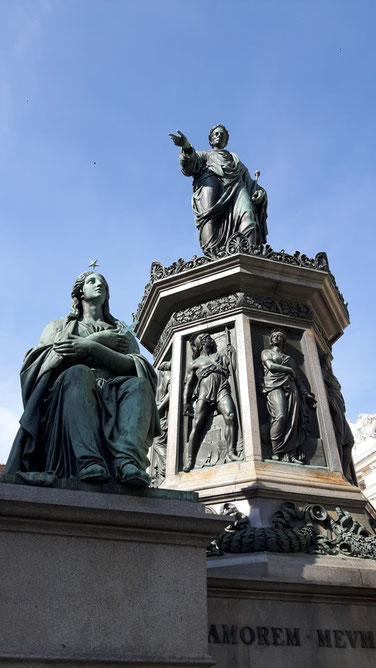
Emperor Franz II / I, who took part at her Christmas ceremony, gave the order to set up a candle-decorated Christmas tree in the Hofburg.
Noble families followed the example of the court, but it took a long time for the Christmas tree to gain acceptance in Vienna.
The Christmas tree with the candles caused such enthusiasm among the Viennese nobility and the artists of the time that many followed their example in the following year.
Today there is hardly a Viennese family that does not have their Christmas tree.
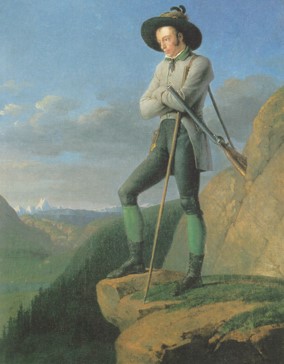
In 1822, Carl and his family moved into the palace of his adoptive father, Albert Kasimir von Sachsen-Teschen, who died at the beginning of the year (today's Albertina).
When his brother Archduke Johann visited Carl in 1823, he saw a large tree of lights there.
It is also reported from Rudolf von Alt that a Christmas tree was set up in his parents' house in 1817.
When the actor Heinrich Anschütz was planning a public Christmas present with a Christmas tree in 1821, he met a lack of understanding among the population.
Gradually, it became a matter of fashion in Vienna to have a Christmas tree on Christmas Eve, but this happened only reluctantly in Catholic circles because the Christmas tree threatened the supremacy of the Christmas crib.
The religious and social change was made undoubtedly by changing the time of the giving of presents (with a Christmas tree) from St. Nicholas' Day at Christmas Eve.
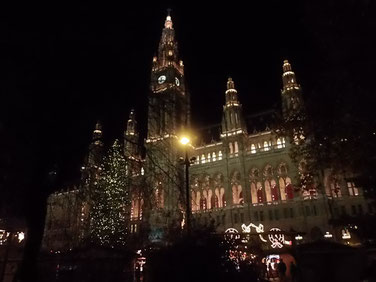
The first public Christmas tree was in Währing, as a diary note shows, in 1829 which stayed in front of the Villa of Friedrichs von Gentz (18, Währinger Straße 169-171). In the same year, trees were offered for sale at the Schottentor. In 1851, according to a contemporary report, the Am Hof square looked like a forest in the run-up to Christmas, and numerous trees were also offered for sale in Mariahilf.
Every year since 1959 a big Christmas tree (donated alternately by the Austrian federal states or even neighbour countries) about 30 meters high stand in front of the Town Hall which since 1975 it has been the center of Vienna's largest Christmas market. In 1986 this tradition was interrupted because of the "forest dies".
The tallest Christmas tree ever exhibited in Vienna was 39.4 meters high and came from Styria in 1971.
Like the disused Christmas trees that are handed in at the collection points of Municipal Department 48 - (Waste Management, Street Cleaning and Vehicle Fleet)-, the felled Christmas trees from Town Hall Square are also used to generate electricity and district heating.
Merry Christmas
© 2020 Nicoleta Schiel


















